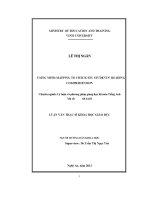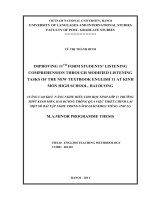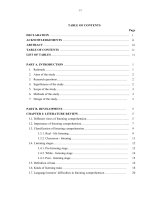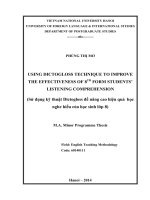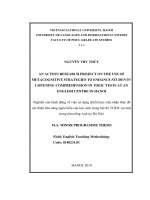Anxiety factors affecting EFL students’ listening comprehension
Bạn đang xem bản rút gọn của tài liệu. Xem và tải ngay bản đầy đủ của tài liệu tại đây (15.56 MB, 8 trang )
Vol 8. No 4_October 2022
TẠP CHÍ
ISSN: 2354 - 1431
/>
TẠP CHÍ KHOA HỌC ĐẠI HỌC TÂN TRÀO
TẠP CHÍ KHOA HỌC ĐẠI HỌC TÂN TRÀO
SCIENTIFIC JOURNAL OF TAN TRAO UNIVERSITY
KHOA HỌC GIÁO DỤC
SCIENTIFIC EDUCATION
Tập 8, Số 4 - 10/2022
ISSN: 2354 - 1431
Tập 8, Số 4 (Tháng 10/2022)
Volume 8, Issue 4 (October 2022)
ANXIETY FACTORS AFFECTING EFL STUDENTS’ LISTENING
COMPREHENSION
Do Thuan Giang, Le My Thu
University of Economics – Technology for Industries
Địa chỉ email:
DOI: />
Article info
Received:07/08/2022
Revised: 10/09/2022
Accepted:25/10/2022
Keywords:
anxiety factors, student
listening anxiety, listening
comprehension, Foreign
Language Listening
Anxiety Scale (FLLAS).
Abstract:
The mixed-method study sheds light on the factors influencing 84 non-English
major sophomores’ listening anxieties in a public university in Vietnam.
The questionnaire adapted from Kim (2000) and semi-structured interviews
were employed to discover students’ anxiety levels related to teacher factors,
student factors, and materials during their listening process. The findings show
a high frequency of anxiety experienced by many students when they were
distracted during the listening process. Secondly, the concern emerges from
unfamiliar English pronunciation and accents, which led to students’ difficulty
understanding English audio recordings. As a third obstacle, the speaker may
experience discomfort if they speak at a fast speed, which pertains to the second
concern of being overworked. Lastly, students’ nervousness during listening
sessions was worsened by instructor-related worries. Though there was still
restraint, several pedagogical implications were additionally presented in the
field to help increase students’ anxiety in EFL listening classes.
|101
Vol 8. No 4_October 2022
TẠP CHÍ
ISSN: 2354 - 1431
/>
SCIENTIFIC JOURNAL OF TAN TRAO UNIVERSITY
TẠP CHÍ KHOA HỌC ĐẠI HỌC TÂN TRÀO
TẠP CHÍ KHOA HỌC ĐẠI HỌC TÂN TRÀO
KHOA HỌC GIÁO DỤC
SCIENTIFIC EDUCATION
Tập 8, Số 4 - 10/2022
ISSN: 2354 - 1431
Tập 8, Số 4 (Tháng 10/2022)
Volume 8, Issue 4 (October 2022)
CÁC YẾU TỐ LO LẮNG ẢNH HƯỞNG ĐẾN KHẢ NĂNG NGHE HIỂU
CỦA SINH VIÊN KHÔNG CHUYÊN TIẾNG ANH
Đỗ Thuận Giang, Lê Mỹ Thu
Trường Đại học Kinh tế - Kỹ thuật Công nghiệp
Email address:
DOI: />
Thông tin bài viết
Ngày nhận bài: 07/08/2022
Ngày sửa bài: 10/09/2022
Ngày duyệt đăng: 25/10/2022
Từ khóa:
Các yếu tố lo lắng, nỗi lo
lắng khi học nghe, khả năng
nghe hiểu, Foreign Language
Listening Anxiety Scale
(FLLAS).
Tóm tắt
Nghiên cứu theo phương pháp hỗn hợp làm sáng tỏ các yếu tố ảnh hưởng
đến nỗi lo lắng của 84 sinh viên không chuyên năm thứ 2 tại một trường đại
học công lập ở Việt Nam trong giờ học nghe. Nghiên cứu thu thập dữ liệu
qua Bảng câu hỏi khảo sát phỏng theo Kim (2000) và phỏng vấn bán cấu
trúc, nhằm tìm hiểu nỗi lo lắng của sinh viên liên quan đến yếu tố về giảng
viên, sinh viên và tài liệu sử dụng trong giờ học nghe. Kết quả cho thấy
sinh viên lo sợ nhất là mất khả năng tập trung trong quá trình nghe, cách
phát âm và giọng điệu lạ, tốc độ của bài nghe và các biểu hiện của giảng
viên dạy nghe. Nghiên cứu cũng chỉ ra một số hạn chế đồng thời cung cấp
một số đề xuất sư phạm nhằm giảm tải nỗi lo lắng của sinh viên trong giờ
học nghe tiếng Anh.
1. Introduction
Most listeners of English as a foreign language
(EFL) cannot comprehend what the speaker is saying
(Vogely, 1998). While listening involves hypothesizing,
predicting, generalizing, modifying, and verifying,
anxiety interferes with the ability to comprehend
speech (Vandergrift, 1997). Multiple research (Kim,
2000; Kimura, 2008; Vogely, 1998) concur that anxiety
impacts EFL acquisition. The anxiety associated with
speaking, listening, or learning a second language is
known as language anxiety (Maclntyre & Gardner,
1994). Listening is viewed as a challenging skill,
and meaning is generated via the dynamic process
of listening comprehension. Listeners may utilize
pertinent information and existing knowledge to
complete the assignment (Tran et al., 2019). Detailed
listening comprehension frustrates and frightens EFL
102|
students; consequently, anxiety hinders the ability to
learn (Kim, 2000). Anxiety over a second language may
also harm motivation and language learning (Maclntyre
& Gardner, 1994). In particular, anxiety impairs
an individual’s capacity to listen and understand.
Moreover, anxiety diminishes the sensitivity and
responsiveness of the auditory organs, resulting in poor
information comprehension.
According to Fang (2011), anxiety has many
influences on listening comprehension; hence.
Listening anxiety must be examined for successful
second-language instruction. This research examined
students’ moods, anxiety, and performance during
listening comprehension exercises. Without negative
marking, this study will assist EFL teachers in course
design and students in achieving academic success.
The research is advantageous since it teaches EFL
Juanito L. Go/Vol 8. No 4_October 2022| p.5-15
teachers about anxiety levels, causes, and methods
for lowering anxiety and enhancing performance. A
Vietnamese university focuses minimal emphasis on the
understanding of spoken language. While it is included
in the curriculum, it is seldom taught. Listening anxiety
in students is brought on by a lack of practice, which
inhibits language learning and decreases performance.
Hence, the research question “What variables affect
the EFL sophomores’ listening comprehension?” was
employed to determine students’ anxiety when they
listen comprehensively.
2. Literature review
2.1. Listening anxiety
Wheeles (1975, as cited in Dalman, 2012, p. 28)
described it as the fear of not comprehending what
others are saying or misunderstanding what they have
heard. Hence, students suffer anxiety, which has a
connection to the nervous system (Serraj, 2015). It
indicates that student anxiety is linked to their brain
makeup. They were anxious before going to class;
they feared their listening lesson. As a consequence,
the success and failure of second-language learners are
affected by their listening anxiety.
Anxiety about listening has two impacts. In the
first place, these are the incapacitating, inhibiting, and
stimulating varieties (Vogely, 1998). Anxiety reduction
may increase student performance. Facilitating
anxiety could be undetected since it does not generate
tension. Secondly, anxiety hinders the learning of a
foreign language. That is debilitating detrimental,
and unhelpful to foreign language acquisition.
Consequently, this results in decreased motivation,
unfavorable attitudes and beliefs, and difficulties in
language competence. According to Kim (2000) and
Gonen (2009), anxiety around listening comprehension
is often neglected despite its significance. In addition,
while many academics understand the significance of
study on learning anxiety, studies on the relevant topic
are limited.
2.2. Factors influencing listening anxiety:
Vogely (1998) describes many forms of listening
anxiety. The instructor, students, listening materials,
and methods are all contributors.
First and foremost, teachers plan and direct the
educational process. It is undeniable that traditional
classrooms strongly emphasize authority and the
teacher. Planning is critical for both teaching and
learning. Besides, the instructor’s personality impacts
the students’ listening anxiety. Overly serious
professors may exert class pressure. Thus, outgoing
and laid-back professors are amused in class, which
helps students relax. The teacher’s attitude toward the
students’ listening faults will not worry them.
Students are the second variable. The ability of
students to listen has an impact on the outcome. The
priority is listening comprehension. Anxiety rises when
a student’s listening comprehension is poor, and vice
versa. Moreover, linguistic understanding (lexicon,
syntax, and grammar) and listening competence
compose listening capacity (the ability to catch
essential words, predict the following information,
etc.). Moreover, the audience’s sense of selfefficacy must be correspondingly considered. Both
urgency and anxiety are influenced by self-efficacy.
Students confident in their listening abilities are more
observant and proficient at picking up on indirect
information. Listeners with poor self-efficacy doubt
their talents when faced with challenging tasks. They
give up because stress and anxiety impair listening
comprehension. In terms of habits, many language
students do not practice listening outside class and are
unmotivated in class, resulting in poor listening skills
and frequent absences. This habit is worrisome because
it encourages students to reject critical facts. Their
wants influence learners’ listening anxiety to succeed.
Create positive expectations and demanding learning
objectives to calm learners. Achievement motivation is
the inherent determination to perform things well that
motivates people to achieve their goals.
Among the things to look into are listening materials.
Regarding difficulties and listening anxiety, the more
complex the language is, the more intricate the issue
becomes, which leads to the quicker the tempo, the
fewer the pauses. The audience may experience terror
as a result of these occurrences. Listening is influenced
by the content, duration, pace, and language of listening
materials. Complications may arise if the listening
text is irrelevant in the case of a new subject, which
makes it harder for EFL listeners to learn and recall.
The second factor is anxiousness. Listening cannot
be repeated; hence, others who cannot understand are
concerned. Furthermore, inadequate processing time
causes concern. Listeners feel pushed and nervous
when asked to answer a question promptly.
2.3. Relevant studies
Tran et al. (2013) investigated the familiarity of EFL
students and teachers with foreign language anxiety.
The author delivered the survey to 419 Vietnamese
non-English majors and 8 EFL teachers. It triangulated
data using surveys, interviews, and student memoirs.
More than two-thirds of students indicated anxiety
while learning a foreign language. Despite this, there
remained a lack of classroom focus. Most learners
dislike learning a foreign language; thus, teachers
should design courses appropriately.
Zhai (2015) used quantitative and qualitative
methods to investigate students’ anxieties about
|103
Juanito L. Go/ol 8. No 4_October 2022| p.5-15
English listening comprehension. Participants were
eighty-two first-year English majors from a typical
college. Participants’ anxiety levels were assessed
using a modified version of a foreign language
listening questionnaire, and the underlying reasons
were determined via in-depth interviews. The paper’s
analyses advocate firstly, freshmen English majors do
experience slightly more listening anxiety; secondly,
there is a significant negative correlation between
anxiety and listening comprehension; and finally, the
primary causes are a lack of confidence and listening
strategies, characteristics of listening comprehension
and materials, and fear of negative evaluation. Using
this discovery as a launching point, numerous practical
suggestions were made to assist students in enhancing
their listening abilities and the current condition of
listening classrooms.
Serraj (2015) shed insight into the factors that
influence listening concerns. Individual features,
input variables, and environmental factors contribute
to listening anxiety. Anxiety, negative emotions, poor
decision-making, and a lack of readiness are individual
challenges that may impact students. However,
contextual influences, such as those in the classroom,
impact students’ listening anxiety. Instructors, students,
and the overall classroom atmosphere all have an
effect. Time constraints, the absence of visual cues, the
spoken language’s distinctiveness, and the difficulty
level are examples of auditory input elements. It was
discovered that these traits affected students’ listening
anxiety levels. Lastly, when children are worried about
their hearing, they do poorly in listening activities.
Tran (2019) examines anxiety among EFL students
at Hanoi National University of Education. Exams,
oral exercises, teachers’ speaking speeds, and students’
self-evaluations of their abilities relative to their peers
are common sources of anxiety in foreign language
studies. In foreign language classes, great emphasis is
placed on calming students’ thoughts. First, semesterlong examinations must contain questions assessing
students’ communication and listening abilities.
Teachers must also teach interactional skills so students
can talk in the target language and their native tongue.
Teachers may lessen classroom anxiety by fostering
cooperative learning and allowing students sufficient
time to prepare for assignments. Students are permitted
to sit in circles, work in pairs or small groups, and move
around as necessary for games and activities.
3. Methodology
3.1. Research design and settings
A mixed method study design is the process of
collecting, evaluating, and synthesizing data from both
quantitative and qualitative sources. One study adopted
this method better to comprehend research concerns
104|
(Creswell, 2012). The results from the student survey
were evaluated quantitatively. In contrast, a qualitative
technique was used to transcribe the students’ replies to
the questionnaire into narratives or words, followed by
interviews with an English instructor and three students.
Participants in the study were 84 second-year students
from a public college in Vietnam who were not English
majors. The sophomores were chosen because, based
on first observations, they were adequately prepared for
the end-of-semester English exam.
3.2. Data collection instruments and data analysis
Using a questionnaire, the researchers first evaluated
the factors influencing students’ listening discomfort. This
survey is based, with slight modifications, on Foreign
Language Listening Anxiety Scale (FLLAS) adapted
by Kim (2000). The 20-item survey explored variables
impacting students’ listening anxiety. They were required
to read each sentence attentively and indicate whether
they strongly disagreed, disagreed, not decided, agreed,
or strongly agreed. Participants were given a permission
form to complete to indicate their desire to serve as data
sources, and their anonymity was guaranteed. The survey
was disseminated via Google forms.
After analyzing and classifying the quantitative
survey results, in-depth interviews were conducted
with six students with the highest listening anxiety and
eagerness to be recruited.
Using BMI SPSS version 25.0, the FLLAS survey
data were tabulated and analyzed for insights into
the research issue. Meanwhile, the interview was
transcribed verbatim and examined using theme
analysis to understand what causes students to
experience listening anxiety.
Reliability Statistics
Cronbach’s Alpha
N of Items
.874
20
Figure 1. Reliability and validity analysis of FLLAS
questionnaireFigure 1 depicts Cronbach’s alpha at.874,
showing that FLLAS has an excellent internal coefficient.
Consequently, the FLLAS is a viable instrument for further
statistical analysis.
4. Findings and discussion
From the data obtained from the questionnaire and
the interview, the results were categorized into three
factors (listening material, teacher-related factors, and
student-related factors) that lead to their anxiety in
listening.
4.1. Teacher-related factors
The teacher-related factor is related to how the
lecturer guides and teaches the class. The way the
lecturer leads the class is going to affect the level of
anxiety of the students in the class.
Juanito L. Go/Vol 8. No 4_October 2022| p.5-15
Table 1. Teacher-related factors affecting students’ listening anxiety
Mean
Std. Deviation
The teacher’s behavior and manner make me nervous
4.66
.840
The teacher open show frustration when I don’t know the answer
4.50
.836
I feel worried and anxious when I am evaluated
4.72
.723
When the teacher speaks in English, I am anxious that I cannot understand
4.58
.989
I am worried if I do not know what the teacher is correcting
4.75
.535
I am worried if the teacher is ready to correct every mistake
4.81
.588
I feel uncomfortable around teachers speaking English
4.03
.975
Table 1 indicates that the students got primarily
anxious when the teacher was ready to correct every
mistake they made (M=4.81). The following issue
made students worried when they did not know they
were being corrected or evaluated (M=4.75, M=4.72).
It could be explained when the teacher was too severe
with the lesson. It might make the students feel anxious
and worried that they would not be acceptable in the
class; otherwise, if the teacher was humorous and calm,
it made the students feel comfortable and less anxious.
It also happened in the situation when the teacher gave
the students a question, and they did not answer it
correctly. The teacher could be either disappointed, and
it was going to raise the level of anxiety of the students,
or the lecturer could be merely calm and explain clearly
what the mistake made by the students, resulting in less
anxiety among students. The interview also supported
this finding that one student reported, “… I think I will
be frustrated when the teacher shows the behavior like
that when I am called to answer the questions or do the
exercise. It feels like the teacher is letting me down. It is
all right for me when the teacher behaves like that faceto-face. However, I don’t want to be treated like that
in front of the class, particularly my friends because it
will make me embarrassed like I am the foolish person
in the class…”.
A possible explanation is that the respondent felt
much anxiety toward that kind of teacher’s behavior.
He thought it would make him sad, embarrassed, and
scared in listening class. He thought the lecturer was
not supposed to do that to the students. If the teacher did
it, it had to be face-to-face with the student itself, but if
Qualitative data from the interview indicates that the
language teacher’s role is a critical factor influencing the
degree to which students fear listening to new content.
Every respondent believes their instructor is the most
significant individual for minimizing their listening
anxiety and making them feel more comfortable during
listening exercises. Several students commented that
lecturers significantly cause anxiety in their listening
lessons. They struggle to comprehend complicated
listening tasks and meet their professors’ expectations.
According to Vogely (1998), learners experience
anxiety over listening comprehension when instructors
have high expectations and are critical of students
who provide incorrect responses. Tran et al. (2013)
suggest that instructors of foreign languages should
avoid depending only on listening production systems
that demand students to produce the correct replies
since doing so may distract students and increase their
anxiety. Rather than being the exclusive emphasis of the
course, foreign language instructors should encourage
their students to make errors and see them as part of
the learning process. This may help students overcome
the common worry of “losing face” in language lessons
(Tran et al., 2013). Moreover, if FL teachers can make
their students feel comfortable and encouraged, they
may assist their students in gaining self-confidence
(Zhai, 2015).
4.2. Student-related factors
In terms of student factors, it is strongly related to
the students themselves. It is interconnected with how
the students manage themselves in listening class, such
as their ability, self-esteem, motivation, and, most
the lecturer did it in front of many people or friends, it
importantly, the student’s interest in listening. Table
would make him embarrassed, and he thought that the
2 demonstrates student-related factors impacting their
lecturer did not support him.
listening anxiousness.
|105
Juanito L. Go/ol 8. No 4_October 2022| p.5-15
Table 2. Student-related factors affecting their listening anxiety
Mean
4.13
4.00
4.73
4.69
4.16
4.00
4.19
I am stuck on one or two unknown words
I often guess the missing part
I mind drifting
I differentiate the words
I have little time to think
I often translate words while listening
I do not understand what the speakers are saying
The more the students have no interest in listening,
they are going to have an empty brain when they come
toward the class because they have no idea what to do
during the listening lesson runs, and when they have
the task, they might have worried that they do not know
what to do with that and it results with the lack of ability
in listening comprehension. Table 2 shows that students
selected their lack of concentration most frequently to
increase their anxiety (M=4.73). They were afraid that
they could not catch the critical information or idea.
The student feels anxious about losing an important
idea from the English recording. They feel difficult to
focus when listening to an English recording and feel
anxious if he only does not know what is being said by
the speaker in the English recording. So, the students
had to stay focused when listening to the audio.
Besides, the students only master a little about English
vocabulary, so they cannot understand what the speaker
is talking about. This result is that the students do
misinterpret the meaning and loss information relating
to the contents of the English recording. The result was
also proved by the qualitative data from the interview
“… If I even think the other things while listening, I
will lose the important information of listening even
a second. I will do not know what to fill in the paper.
Even if I focus, I still lose the point of listening itself.
So, I should keep concentration and focus not to lose
that. That’s only way…” Another student also stated
that he sometimes felt worried because he could not
get the core of the speaker’s utterance. He did not
focus to the recording because he thought of something
Std. Deviation
1.291
1.039
.718
.889
.996
.959
1.153
else. It could be concluded that the students often lost
important information while listening. They lost that
because they sometimes thought about things other
than listening or daydreaming of something, then the
students lost the points of the listening itself. According
to the respondent, he thought he had to stay focused
while listening to get the vital information from
listening audio.
The findings align with those of Kim (2000),
Serraj (2015), and Tran et al. (2013). The unfamiliarity
created significant challenges with the subject matter
and required students to pay close attention while
listening to the recording. As a result, students are
unable to concentrate during classroom lectures. A
primary indicator of more significant anxiety while
listening is a lack of focus. During lectures, it was usual
for students to stress and daydream, resulting in poor
listening abilities. Due to the intricacy of the listening
process, students must pay great attention to the phrase
they hear to form a mental image of it.
4.3. Listening materials
Listening material is the material used in the
listening skill, especially audio used in the listening
class. However, listening material is one of the factors
that cause the increasing level of listening anxiety in
advanced listening classes. It occurs due to the nature
of speech in listening and unfamiliar topic listened to
by the students, and the unfamiliar topic of the listening
material.
Table 3. Listening materials affecting students’ listening anxiety
106|
Mean
Std. Deviation
The recording pronounces word differently from the way I pronounce it
4.36
.824
The speed of the recording is so fast
4.52
.891
I am anxious because I cannot see the facial expressions of people in the recording
4.17
.883
I often listen to the recording without written texts
4.17
.883
I am anxious when I am not at my pace while listening
4.11
.779
I am anxious when l listen to the native speakers on the phone or imagine that things happen
4.27
.877
Juanito L. Go/Vol 8. No 4_October 2022| p.5-15
Most students thought that fast-speed listening
exercises (M=4.52), then their incapacity to recognize
the pronunciation (M=4.36) helped increase their
anxiety. It was said that if the people in the audio spoke
too fast, they might not understand what they were
saying. They thought it made them feel incompetent
in their listening material which tended to make them
misunderstand what the people were saying in the
audio. As a result, the students could not catch any
idea of the audio. This finding was backed up by the
interviewee, who reported, “… it is hard to understand
people speaking too fast, especially with unfamiliar
pronunciation…”. The respondent felt anxious when
she hardly recognized people’s different pronunciations
other than hers. She had anxiety because she thought
it was challenging to understand the people who had
different pronunciations from her. After all, it could
make her feel confused and not know what to say to
people.
This finding supports Serraj’s (2015) claim that the
intrinsic ambiguity of language exacerbates students’
anxiety. Kim (2000) and Vogely (1998) highlight speech
rate and unfamiliar pronunciation as contributing
factors to students’ anxiety in listening lessons. Vogely
(1998) revealed that one-third of the participants
reported feeling worried due to the quick speech pace
and strange accents. This finding is congruent with Zhai
(2015), who discovered that students had difficulties
comprehending the recording’s content, but if it had
been played slower, they would have gotten its gist.
This is reinforced by the findings of Tran (2019), who
argues that the inability to regulate the speaking pace
significantly contributes to the perception that listening
is a challenging skill.
Participant interviews revealed that when students
perceive listening material to be difficult, they feel
anxiety. The usage of specialist terminology influenced
participants’ evaluations of the difficulty of hearing
input, the complexity of the grammatical structures
used, and the novelty of the topics presented in the texts
being read. In many instances, it seems that students
are unable to manage the difficulties that listening
comprehension presents and are unable to tolerate
ambiguity throughout the listening for the meaning
process. As a result, people become less concentrated,
worsening their anxiety. This is consistent with
Vogely’s (1998) assertion that the structural aspect
of the information adds to the difficulty of hearing
comprehension. Some listeners may erroneously
believe they can only comprehend the portions of
the speech whose vocabulary and grammar they are
unfamiliar with. This implies that substantial lexical
and grammatical knowledge is required. Instead of
inferring the meaning from the context, these viewers
must labor to decode the text’s complex structures.
They often gloss over critical phrases in the content,
which hinders understanding. Consequently, anxiety
and tension would increase throughout any tasks
demanding listening comprehension.
5. Conclusions, limitations, and implications.
The study shed light on the elements that impact
listening concerns. The detected listening anxiety
variables may be classified into teacher-related factors,
student-related factors, and listening materials. Anxiety
is a common emotion, but it is not necessarily bad. The
findings point to several factors contributing to students’
nervousness while listening to English. Students are
first concerned about their minds drifting, which
might lead to misunderstanding. Students struggle to
understand English audio recordings due to unfamiliar
English pronunciation and accents. The next barrier is
the fast speed rate, which makes them uncomfortable.
Finally, worries about the lecturer heightened students’
uneasiness throughout listening lessons.
Certain limits remain as a consequence of the
constrained nature of the circumstances. The sample
size of 84 students who are not English majors is
inadequate to be representative, and there is an
overemphasis on self-reported data. The following
principles for assuaging students’ anxieties during
class listening have been produced based on prior
research. First, it is recommended that students learn to
recognize the signs of listening anxiety in themselves.
Students should participate in as much listening
practice as possible before class begins to overcome
their aversion to hearing. Secondly, it is advised that
teachers work to alleviate students’ concerns about
listening during class. The first thing a teacher can do
to alleviate students’ concerns and encourage them to
learn more about listening is to establish a pleasant
classroom environment. In order to boost the students’
concentration, the teacher should adopt a funny tone.
Thirdly, future research should look at strategies for
soothing students’ anxiety during listening exercises and
the most effective ways for instructors to interact with
their students during the session. It is recommended that
more studies be undertaken on the reasons and amount
of listening anxiety experienced by these students since
they are enrolled in an advanced listening course does
not mean that their concern is insignificant.
REFERENCES
[1]. Cresswell, J. W. (2012). Educational research:
Planning, conducting and evaluating quantitative
and qualitative research (4th ed.). Boston: Pearson
Education.
[2]. Dalman (2012). Listening Anxiety: The
Relationship between Listening Anxiety, Listening
|107
Juanito L. Go/ol 8. No 4_October 2022| p.5-15
Comprehension Strategies, and Listening Performance.
German: Lambert Academic Publishing.
[3]. Fang, X. (2011). Anxiety in EFL listening
comprehension. Theory and Practice in Language
Studies, 1(12), 1-3.
[4]. Kim, J. H. (2000). Foreign language listening
anxiety: A study of Korean students learning English.
Doctoral thesis. University of Texas, Austin.
[5]. Kimura, H. (2008). Foreign language listening
anxiety: Its dimension and group differences. JALT
Journal, 30(2), 173-196.
[6]. MacIntyre, P. D., & Gardner, R. C. (1994).
The subtle effects of language anxiety on cognitive
processing in the second language. Language learning,
44(2), 283-305.
[7]. Gonen, M. (2009). The relationship between
FL listening anxiety and FL listening strategies: The
case of Turkish EFL learners. In Proceedings of the
5th WSEAS/IASME International conference on
educational technologies (pp. 44-49).
108|
[8]. Serraj, S. (2015). Listening anxiety in Iranian
EFL learners. International Journal of Scientific and
Research Publications, 5(6), 1-8.
[9]. Tran, T. T. X. (2019). Anxiety in foreign
language classrooms at Hanoi National University of
Education. Vietnam Journal of Education, 6, 60-64.
[10]. Tran, T. T. T., Moni, K. and Baldauf Jr., R.
B. (2019). Foreign language anxiety: Understanding
its sources and effects from Insiders’ perspectives. The
Journal of Asia TEFL, 10(1), 95-131.
[11]. Vandergrift, L. (1997). The comprehension
strategies of second language (French) listeners: A
descriptive study. Foreign Language Annals, 30(3),
387-409. DOI: 10.1111/j.1944-9720.1997.tb02362.x.
[12]. Vogely, A. J. (1998). Listening comprehension
anxiety: Students’ reported sources and solutions.
Foreign Language Annals, 31(1), 67-80.
[13]. Zhai, L. L. (2015). Influence of Anxiety on
English Listening Comprehension: An Investigation
Based on the Freshmen of English Majors. Studies in
Literature and Language, 11(6), 40-47.
